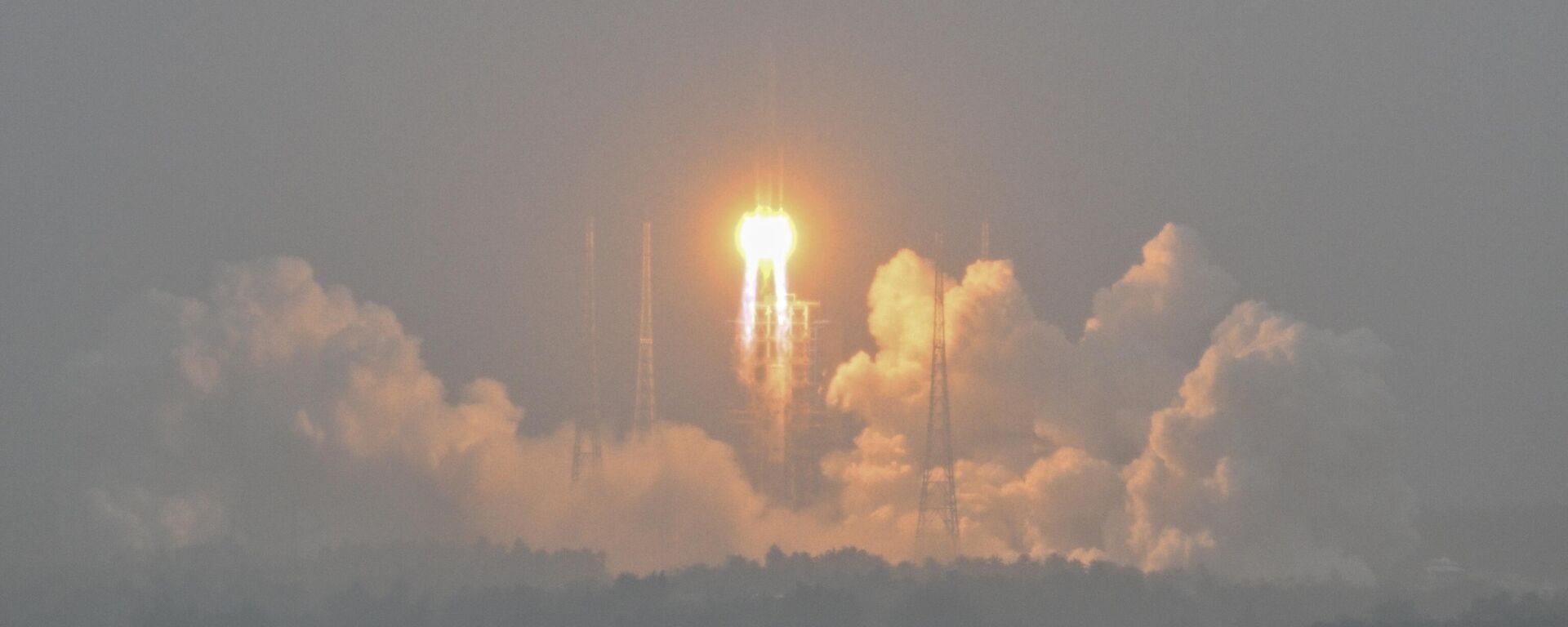https://sputnikglobe.com/20240626/china-successfully-completes-first-10-km-vertical-takeoff-landing-test-of-reusable-launch-vehicle-1119139519.html
China Successfully Completes First 10-Km Vertical Takeoff, Landing Test of Reusable Launch Vehicle
China Successfully Completes First 10-Km Vertical Takeoff, Landing Test of Reusable Launch Vehicle
Sputnik International
China's first 10-kilometer vertical takeoff and landing flight test of a reusable launch vehicle was successfully completed on Sunday, marking its largest takeoff and landing of a reusable launch vehicle to date and the first application of a domestically developed deep-throttling liquid oxygen-methane engine in a 10-kilometer return flight.
2024-06-26T12:52+0000
2024-06-26T12:52+0000
2024-06-26T12:52+0000
world
china
jiuquan satellite launch center
space exploration
space rockets
test launch
https://cdn1.img.sputnikglobe.com/img/07e8/01/11/1116235493_0:161:3069:1887_1920x0_80_0_0_d7d795e015d000ff273400b124452cde.jpg
A new technology verification rocket for a reusable launch vehicle with a diameter of 3.8 meters stood on the launch pad around 1 pm at the Jiuquan Satellite Launch Center with three variable-thrust liquid oxygen methane engines being ignited, emitting distinctive blue flames.The rocket ascended to about 12 kilometers, then the central engine adjusted its thrust, allowing the rocket to descend in a controlled manner. At 50 meters above the ground, four landing legs deployed, and the rocket slowly descended, approaching zero height, and landed steadily on the recovery pad, achieving a pinpoint vertical soft landing.This test represents the largest-scale vertical takeoff and landing flight test of a reusable launch vehicle in China to date. It is also the first application of a domestically developed deep variable-thrust liquid oxygen methane engine in a 10-kilometer-level return flight.The entire test lasted for about six minutes. The rocket went through five phases including accelerated ascent, decelerated ascent, accelerated descent, decelerated descent, and slow descent, achieving "successful liftoff, precise control, effective deployment, and stable landing."The test fully verified the 3.8-meter diameter rocket body structure, high-load landing cushioning technology, large-thrust highly variable reusable engine technology, dual cryogenic pressurization and delivery technology, high-precision navigation guidance and control technology for return and landing, and health monitoring technology.These advancements have laid the technical foundation for the scheduled first flight of a 4-meter-class reusable launch vehicle in 2025.The liquid oxygen methane engine powers the rocket. After fully combusting, the cryogenic liquid oxygen and methane propellants produce only water and carbon dioxide, making them clean and environmentally friendly.Additionally, they do not cause coking and carbon buildup, which benefits the engine's reusability. Moreover, the low cost of methane production aligns with the commercial development direction of rockets.The landing cushioning system is crucial for the rocket's soft landing. The shock absorbers in the four landing legs can absorb the kinetic and potential energy of the rocket at touchdown, ensuring a smooth landing.In this test, the flight profile's apex was in the stratosphere, approximately 12 kilometers above sea level.In the future, the development team will conduct a 70-kilometer-class vertical takeoff and landing test for the reusable launch vehicle, covering the primary stage flight profile and marking a significant step toward the maiden flight of the reusable launch vehicle.Currently, countries around the world are actively developing reusable launch vehicles, with various recovery methods like parachute recovery, parachute plus airbag recovery, and winged horizontal recovery, each having its own advantages.Vertical takeoff and landing recovery involves modifying the rocket's original shape by adding grid fins, a return control system, and a landing cushioning system. This allows the rocket's first stage to be reused, further enhancing the rocket's launch efficiency and reducing the economic cost of human space exploration.*This article was originally published by Global Times.
https://sputnikglobe.com/20240503/china-launches-ambitious-change-6-lunar-mission-photo-coverage-1118241991.html
https://sputnikglobe.com/20240415/russia-and-china-working-on-sustainable-moon-bases-what-do-we-know-about-them-1117943645.html
china
Sputnik International
feedback@sputniknews.com
+74956456601
MIA „Rossiya Segodnya“
2024
Sputnik International
feedback@sputniknews.com
+74956456601
MIA „Rossiya Segodnya“
News
en_EN
Sputnik International
feedback@sputniknews.com
+74956456601
MIA „Rossiya Segodnya“
Sputnik International
feedback@sputniknews.com
+74956456601
MIA „Rossiya Segodnya“
china's space program, chinese space exploration, china's space launch, china vertical takeoff, china's landing test of reusable launch vehicle
china's space program, chinese space exploration, china's space launch, china vertical takeoff, china's landing test of reusable launch vehicle
China Successfully Completes First 10-Km Vertical Takeoff, Landing Test of Reusable Launch Vehicle
China's first 10-kilometer vertical takeoff and landing flight test of a reusable launch vehicle was successfully completed on Sunday, marking its largest takeoff and landing of a reusable launch vehicle to date and the first application of a domestically developed deep-throttling liquid oxygen-methane engine in a 10-kilometer return flight.
A new technology verification rocket for a reusable launch vehicle with a diameter of 3.8 meters stood on the launch pad around 1 pm at the Jiuquan Satellite Launch Center with three variable-thrust liquid oxygen methane engines being ignited, emitting distinctive blue flames.
The
rocket ascended to about 12 kilometers, then the central engine adjusted its thrust, allowing the rocket to descend in a controlled manner. At 50 meters above the ground, four landing legs deployed, and the rocket slowly descended, approaching zero height, and landed steadily on the recovery pad, achieving a pinpoint vertical soft landing.
This test represents the largest-scale vertical takeoff and landing flight test of a reusable launch vehicle in China to date. It is also the first application of a
domestically developed deep variable-thrust liquid oxygen methane engine in a 10-kilometer-level return flight.
The entire test lasted for about six minutes. The rocket went through five phases including accelerated ascent, decelerated ascent, accelerated descent, decelerated descent, and slow descent, achieving "successful liftoff, precise control, effective deployment, and stable landing."
The test fully verified the 3.8-meter diameter rocket body structure, high-load landing cushioning technology, large-thrust highly variable reusable engine technology, dual cryogenic pressurization and delivery technology,
high-precision navigation guidance and control technology for return and landing, and health monitoring technology.
These advancements have laid the technical foundation for the scheduled first flight of a 4-meter-class reusable launch vehicle in 2025.
The liquid oxygen methane engine powers the rocket. After fully combusting, the cryogenic liquid oxygen and methane propellants produce only water and carbon dioxide, making them clean and environmentally friendly.
Additionally, they do not cause coking and carbon buildup, which benefits the engine's reusability. Moreover, the low cost of methane production aligns with the commercial development direction of rockets.
The landing cushioning system is crucial for the rocket's soft landing. The shock absorbers in the four landing legs can absorb the kinetic and potential energy of the rocket at touchdown, ensuring a
smooth landing.
In this test, the flight profile's apex was in the stratosphere, approximately 12 kilometers above sea level.
In the future, the
development team will conduct a 70-kilometer-class vertical takeoff and landing test for the reusable launch vehicle, covering the primary stage flight profile and marking a significant step toward the maiden flight of the reusable launch vehicle.
Currently, countries around the world are actively developing reusable launch vehicles, with various recovery methods like parachute recovery, parachute plus airbag recovery, and winged horizontal recovery, each having its own advantages.
Vertical takeoff and landing recovery involves modifying the rocket's original shape by adding grid fins, a return control system, and a landing cushioning system. This allows the rocket's first stage to be reused, further enhancing the rocket's launch efficiency and reducing the economic cost of
human space exploration.
*This article was originally published by Global Times. 



